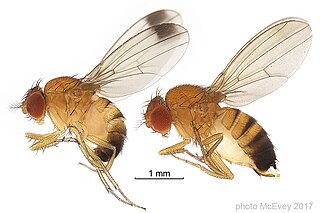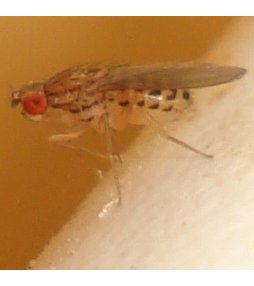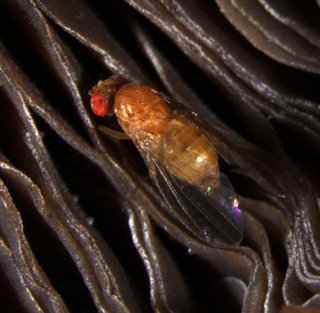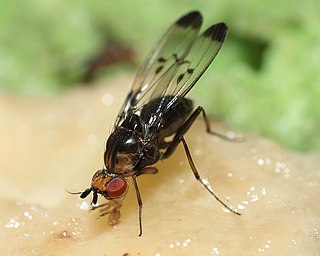
Drosophila is a genus of flies, belonging to the family Drosophilidae, whose members are often called "small fruit flies" or pomace flies, vinegar flies, or wine flies, a reference to the characteristic of many species to linger around overripe or rotting fruit. They should not be confused with the Tephritidae, a related family, which are also called fruit flies ; tephritids feed primarily on unripe or ripe fruit, with many species being regarded as destructive agricultural pests, especially the Mediterranean fruit fly.

Drosophila melanogaster is a species of fly in the family Drosophilidae. The species is often referred to as the fruit fly or lesser fruit fly, or less commonly the "vinegar fly", "pomace fly", or "banana fly". Starting with Charles W. Woodworth's 1901 proposal of the use of this species as a model organism, D. melanogaster continues to be widely used for biological research in genetics, physiology, microbial pathogenesis, and life history evolution. As of 2017, six Nobel Prizes have been awarded to drosophilists for their work using the insect.

Genome projects are scientific endeavours that ultimately aim to determine the complete genome sequence of an organism and to annotate protein-coding genes and other important genome-encoded features. The genome sequence of an organism includes the collective DNA sequences of each chromosome in the organism. For a bacterium containing a single chromosome, a genome project will aim to map the sequence of that chromosome. For the human species, whose genome includes 22 pairs of autosomes and 2 sex chromosomes, a complete genome sequence will involve 46 separate chromosome sequences.
The mechanisms of reproductive isolation are a collection of evolutionary mechanisms, behaviors and physiological processes critical for speciation. They prevent members of different species from producing offspring, or ensure that any offspring are sterile. These barriers maintain the integrity of a species by reducing gene flow between related species.

In human mitochondrial genetics, Haplogroup Y is a human mitochondrial DNA (mtDNA) haplogroup.

Drosophila suzukii, commonly called the spotted wing drosophila or SWD, is a fruit fly. D. suzukii, originally from southeast Asia, is becoming a major pest species in America and Europe, because it infests fruit early during the ripening stage, in contrast with other Drosophila species that infest only rotting fruit.

The subgenus Dorsilopha belongs to genus Drosophila and consists of four species. The phylogenetic position of this group has been unclear for a long time, but recent studies have shown that the subgenus is positioned ancestral to the subgenus Drosophila.

The immigrans-tripunctata radiation is a speciose lineage of Drosophila flies, including over 300 species. The immigrans-tripunctata radiation is a sister lineage to most other members of the subgenus Drosophila. A number of species have had their genomes or transcriptomes sequenced for evolutionary studies using Drosophila.

Scaptomyza flava is an herbivorous leaf mining fly species in the family Drosophilidae. In Latin, flava means golden or yellow. The fly is amber to dark brown in color and approximately 2.5 mm in length. In Europe and New Zealand the larvae are pests of plants in the order Brassicales, including arugula, brassicas, broccoli, Brussels sprouts, bok choy, cabbage, canola, cauliflower, horseradish, kale, kohlrabi, napa cabbage, nasturtium, radish, rapini, rutabaga, turnip, wasabi and watercress. In New Zealand, its range has expanded to include host species that are intercropped with salad brassicas, including gypsophila, otherwise known as baby's breath, which is in the pink family (Caryophyllaceae) and the pea in the Fabaceae. More typically, S. flava is oligophagous within the Brassicales. Scaptomyza are unusual within the Drospophilidae because the group includes species that are truly herbivorous. Other herbivorous drosophilids include D. suzukii, which attacks fruit very early during ripening and species within the genus Lordiphosa, from Africa and Asia, which also include leaf miners. Most drosophilids feed on microbes associated with decaying vegetation and sap fluxes.
Drosophila elegans is a flower-feeding species of fruit flies, belonging to the family Drosophilidae. It is found in Taiwan and the Philippines in Asia.

Drosophila neotestacea is a member of the testacea species group of Drosophila. Testacea species are specialist fruit flies that breed on the fruiting bodies of mushrooms. These flies will choose to breed on psychoactive mushrooms such as the Fly Agaric Amanita muscaria. Drosophila neotestacea can be found in temperate regions of North America, ranging from the north eastern United States to western Canada.

Drosophila testacea is a member of the testacea species group of Drosophila. Testacea species are specialist fruit flies that breed on the fruiting bodies of mushrooms. Drosophila testacea can be found in temperate regions of Europe, extending to east Asia. Drosophila testacea and Drosophila orientacea can produce viable hybrids, though they are separated by geography and behavioural barriers. Drosophila testacea females will also readily mate with Drosophila neotestacea males, but viable hybrids are never produced. This hybrid inviability ) may be due to selfish X chromosomes and co-evolved suppressors. Alternately, differences in sex pheromone reception could underlie female readiness and male willingness to copulate.

The Drosophila testacea species group belongs to the Immigrans-tripunctata radiation of the subgenus Drosophila, and contains 4 species: Drosophila putrida, Drosophila neotestacea, Drosophila testacea, and Drosophila orientacea. Testacea species are specialist mushroom-feeding flies, and can metabolize toxic compounds in Amanita mushrooms. The Testacea species group is studied for its specialist ecology, population genetics, and bacterial endosymbionts. The North American species Drosophila neotestacea is perhaps the best-studied of the group for its interactions with parasitic wasps and nematodes, bacterial endosymbionts, and trypanosomatid parasites. Of note, selfish X chromosomes have been discovered in three of the four Testacea group species.

The Drosophila quinaria species group is a speciose lineage of mushroom-feeding flies studied for their specialist ecology, their parasites, population genetics, and the evolution of immune systems. Quinaria species are part of the Drosophila subgenus.

The Drosophila immigrans species group is a polyphyletic and speciose lineage of Drosophila flies, including over 100 species. Immigrans species belong to the Immigrans-tripunctata radiation of the subgenus Drosophila. Well-described species include Drosophila immigrans, and the sister species Drosophila albomicans and Drosophila nasuta. The genome of D. albomicans was sequenced in 2012 in an effort to characterize novel sex chromosome development in D. albomicans. Immigrans group species are related to mushroom-breeding Drosophila of the Quinaria and Testacea species groups.

Drosophila silvestris is a large species of fly in the family Drosophilidae that are primarily black with yellow spots. As a rare species of fruit fly endemic to Hawaii, the fly often experiences reproductive isolation. Despite barriers in nature, D. silvestris is able to breed with D. heteroneura to create hybrid flies in the laboratory.

The Hawaiian Drosophilidae are a lineage of flies within the genus Drosophila. This monophyletic clade includes all of the endemic Hawaiian Drosophila and all members of the genus Scaptomyza, which contains both Hawaiian and non-Hawaiian species. The Hawaiian Drosophilidae are descended from a common ancestor estimated to have lived 25 million years ago. Species of Hawaiian Drosophilidae flies have been studied as models of speciation and behavioral evolution. Along with other members of the native Hawaiian ecosystem, the conservations status of many species of Hawaiian Drosophilidae is threatened by habitat loss and introduced predators, among other factors.

In this Chinese name, the family name is Long.
Cynoglossus semilaevis, commonly known as the Chinese tongue sole, is a popular aquaculture flatfish species. They are native to China's northern coast but have experienced overfishing these past three decades. Tongue sole farming began in 2003 and they have since become a popular, expensive seafood. However, tongue soles have created issues for farmers due to their pathogen susceptibility and uneven sex ratio.













